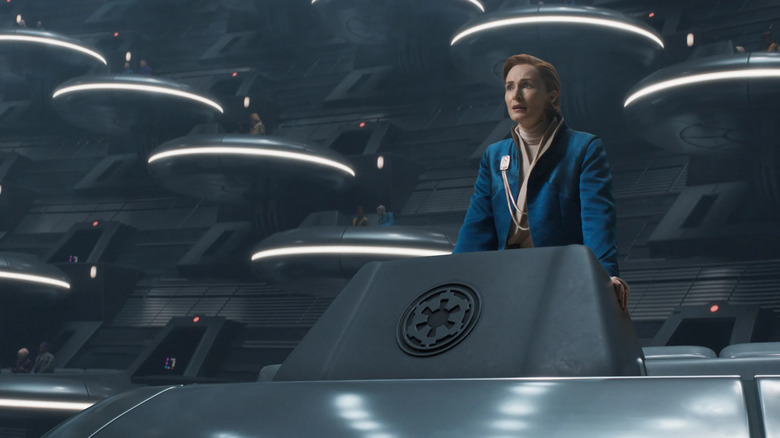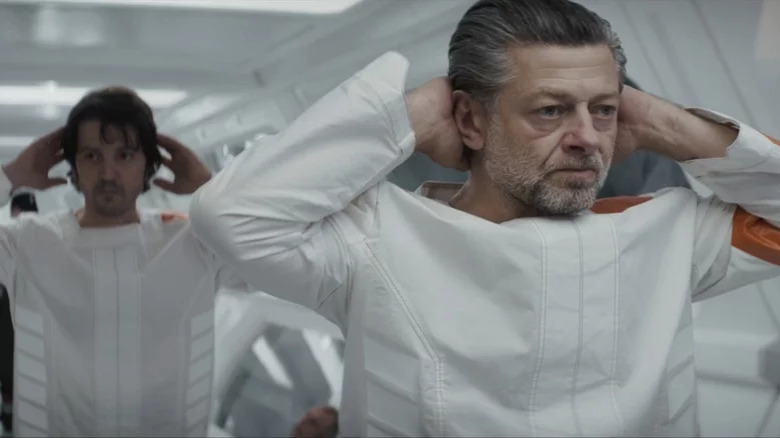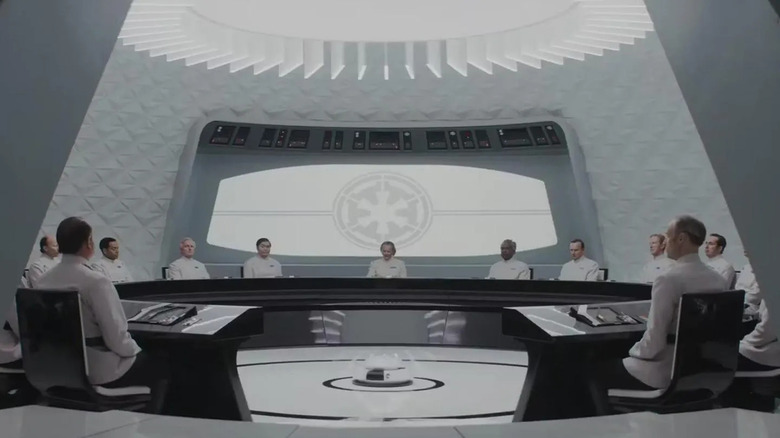Andor Is The Closest We've Got To The Promise Of Star Wars: Underworld
After the "Star Wars" prequels ended, the franchise was all but dead. There was no more story to tell, and you were either too angry to care, or happy enough with how the trilogy ended to not care. After all, what was left? The gaps in the story were filled, and even the post-"Return of the Jedi" events were covered in the expanded universe, canon or not.
That changed at the fan convention Star Wars Celebration III in 2005. During a panel with George Lucas himself, it was announced that "Star Wars" would enter the TV world. Not only did they announce the 3D, half-hour version of "The Clone Wars," but also a live-action show titled "Star Wars: Underworld."
Though we don't know much about what that show would have looked like, we know that the aim was to make something more serious and unlike anything in the franchise up to that point. "'Deadwood' in space" and "'Empire Strikes Back' on steroids" being used to describe the tone of the series, which would have been "much darker, grittier" and "much more character-based" than the plot-heavy films. There would be no Jedi, and barely any major character from the movies. The plot would be disconnected from the main films, though it would touch on them. It would focus on the greasy, seamy underbelly of Coruscant, where criminals, bounty hunters, spies, and mercenaries thrived.
Eventually, some elements of the show made their way to the larger "Star Wars" franchise. Lucas' dream of using virtual sets made headlines when it became a key component of the production of "The Mandalorian," while the character of Saw Gerrera — originally meant to debut in "Underworld" — made his debut in "The Clone Wars." As for "Underworld," the show proved too ambitious and expensive, and it never made it to production. But even if we already got a show focused on a bounty hunter, it wasn't until "Andor" that star wars finally fulfilled the promise of Lucas' "Star Wars: Underworld."
A greasy, seamy world
Granted, "Andor" isn't entirely focused on the underworld of Coruscant, and it isn't focused on a bounty hunter, but it is still pretty disconnected from the movies, instead telling its own story with new characters, not one of them a force user. Indeed, "Andor" has more in common with the original intent of "Deadwood" in space than, say, "Buck Rogers" or "Flash Gordon." This is a compelling drama without the fantasy-heavy, hero's journey narrative focus of the movies. Instead, "Andor" is possibly the first "Star Wars" title that actually feels like science fiction, with grand ideas about politics and humanity, a dystopic futuristic setting, and compelling characters that feel human. It is a show that reminds us of our own world, where we are, and where we could be heading, rather than the fairy tales that inevitably follow from the opening, "A long time ago in a galaxy far, far away ..."
"Andor" is a slow burn of a show, one where the overarching story doesn't necessarily move a lot on a week-to-week basis, where the fate of the galaxy doesn't stand at risk every episode. And yet, we've got more character development, more insight into how our characters think, and what their motivations and aspirations are than most "Star Wars" live-action projects. We're seeing the radicalization of people on both sides of the conflict, including the lamest, most pathetic villain in "Star Wars" history, but also the rise of heroes and rebels simply too tired to stand idly by.
A dark world full of cruelty and rebellion
"Andor" also gives us something we had never really seen before in the live-action "Star Wars" universe, though it would have been part of "Star Wars: Underworld." If "Underworld" was supposed to be about how the exploits of the Jedi and the oppression of the Empire affected the common folk without magical powers or sacred bloodlines, then "Andor" is giving us Victor Hugo's "Les Misérables" in space.
Indeed, never before has the Empire been portrayed as truly evil and cruel as it is in "Andor," which has given us plenty of reasons to hate them, from their unsympathetic view of other cultures, to their cruel bureaucracy, to endorsing actual torture. This is closer to "The Empire Strikes Back" than any other "Star Wars" movie, as "Andor" paints a picture of a world where Han Solo needed to shoot Greedo first or he'd get killed, a world so devoid of hope that it would be believable for Han Solo not to think the force is a real thing, for people to simply endure so much pain that they eventually forget the Jedi were a thing, let alone a good thing.
This is a universe so far removed from the fantasy of, say, "Return of the Jedi" or "The Force Awakens," that it makes perfect sense for the Emperor to need the bureaucracy of the senate, or for him to need the Death Star once he dismisses the senate as his one way to hold the galaxy together — in fear. This is the first time "Star Wars" has made Obi Wan's comment about "the dark times" in the original film feel like something real and not just a cheesy line, and it is the show that is fulfilling the promise of what was meant to be the first "Star Wars" live-action show.


